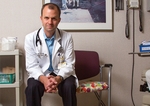business
Office-based doctors support 4 million jobs
■ An AMA report measures the economic impact of practices -- on jobs both inside and outside medical office walls.
By Victoria Stagg Elliott — Posted April 4, 2011
- WITH THIS STORY:
- » Practices' financial impact
- » Jobs in physician offices
- » A booming job market nationwide
- » Related content
Jobs are hard to find in Franklin County, Ill., which has declined with the coal industry and has had double-digit unemployment for all but two months since July 2008.
But one place that has been hiring is Logan Primary Care Services in West Frankfort, Ill. During the past decade, family physician Dennon Davis, MD, has added physician assistants and advanced practice nurses and grown the practice to about 25 staff members.
The West Frankfort office building, owned by Dr. Davis and his six physician partners, has added an occupational and physical therapy tenant. A local hospital has rented space for an x-ray lab and an office for specialists.
"Our practice has continued to grow each year through luck and hard work," Dr. Davis said.
Dr. Davis, a member of the board of the Illinois Academy of Family Physicians, is one of many office-based physicians across the country bringing jobs to a community, even as other industries are slowing down, according to an American Medical Association report released March 23.
"Physicians play a vital role in national and state economies," said AMA President Cecil B. Wilson, MD. "Physicians are not only providing excellent patient care. Physicians provide jobs, purchase goods and generate tax revenue."
"The State-Level Economic Impact of Office-Based Physicians," a report prepared for the AMA by SRC Denton and the Lewin Group, used the input-output modeling system developed by the Minnesota IMPLAN Group to analyze data from the AMA Physician Masterfile and cost information from the Medical Group Management Assn. Researchers devised national and state-specific multipliers to determine the value of a physician's contribution to local economies, including jobs created, spending at nearby businesses and taxes generated.
Using those metrics, researchers estimate that office-based physicians, making up 57.7% of the practicing doctor population, supported 4 million jobs nationally in 2009. These numbers include jobs not only at physician offices but also at vendors serving the practice and at retailers where staff members spend their take-home pay. Physician practices led to $1.4 trillion in economic activity, $833.1 billion in wages and benefits and $62.9 billion in state and local tax revenue.
The AMA report broke down numbers by state, with the median state supporting $10.3 billion in economic activity and more than 46,400 jobs. In most states, jobs and economic impact numbers are comparable to those for hospitals and greater than those for higher education, home health, legal and nursing home industries.
"The report is somewhat surprising," said Dan DeLoach, MD, president of the Medical Assn. of Georgia. "I don't think any of us realized how big of an economic impact physicians were having."
Some state societies have done their own physician economic-impact surveys, but the AMA report is the first national look at the impact of office-based physicians of all specialties. The report documents what people working in community economic development and hospitals have long known: Having physicians around is economically healthy for a community. Even when the unemployment rate has risen, the number of jobs at physician offices has kept going up. According to the U.S. Bureau of Labor Statistics, 463,400 people worked in physician offices in 1972. The number grew to 2,330,000 in 2010.
"These are good-paying jobs with good benefits, and they are stable in comparison to the rest of the economy," said Martin Moll, partner and chair of the health care practice at AKT, a CPA and business consultant firm in Portland, Ore. "And a real medical campus can make a location more desirable for general businesses. Larger employers are looking at everything before moving. If a city has long emergency department waits or it is impossible to get access to a primary care physician, the employer will look at another city."
On an individual level, physicians support an average of 6.2 jobs each, including their own. One physician leads to about $100,000 in state and local tax revenue and $2.2 million in overall financial activity.
The economic impact of physicians has been correlated by other reports by state and specialty medical societies, such as the American Academy of Family Physicians. Hospitals have long been aware of the economic importance of doctors and have been working toward greater alignment in recent years. For instance, a report issued March 17, 2010, by Merritt Hawkins & Associates found that physicians generated an average of $1,543,788 per year for a hospital, an increase from the $1,496,432 in 2007, although this varied by specialty.
The AMA and state medical societies intend to use data in the report released by the Association in their advocacy efforts, as state and specialty societies have done with their economic-impact surveys.
For instance, the Medical Assn. of Georgia intends to use the report to advocate against cuts to Medicaid payment and argue for programs that address the physician shortage in the state. That state's 16,802 office-based physicians translate to $24.3 billion in economic activity and 97,513 jobs. These practices pay out $15.4 billion in wages and benefits and generate nearly $1.1 billion in state and local taxes.
The Tennessee Medical Assn. is using it to advocate for tort reform there. That state's 12,834 physicians produce $17.5 billion in economic output and support 75,191 jobs. These practices pay out $10.7 billion in wages and benefits and pay $542.7 million in state and local taxes.
"If we are going to keep the doctors we have and attract new ones, we must pass these additional reforms to help reduce the threat of lawsuits and improve our overall business climate," said B.W. Ruffner, MD, president of the Tennessee Medical Assn. "The health of our citizens and our economy depends on it."
In West Frankfort, population 8,000, the economy is looking up a little with the return of coal mining in the area, including a new, 350-employee mine that opened in 2010 in Franklin County.
Dr. Davis said he knows his practice will never have the economic impact of such a large operation. But "we are a pretty decent-sized employer," he added, with a fiscal footprint that goes beyond his practice doors.












